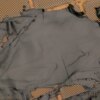In the 1880s Heinrich Hertz discovered that a spark jumping between two pieces of metal emits a flash of light—rapidly oscillating electromagnetic waves—which can be picked up by an antenna. To honor his groundbreaking work, the unit of frequency was named “Hertz” in 1930. Hertz’s findings were later used by Guglielmo Marconi (Nobel Prize in Physics, 1909) to transmit information over long distances creating radio communication and revolutionizing wireless telegraphy—shaping the modern world until today.
Scientists from the Department of Physics and the Regensburg Center for Ultrafast Nanoscopy (RUN), University of Regensburg, have now been able to directly observe a quantum version of Hertz’s spark jumping between just two atoms by measuring the oscillogram of the light it emits with temporal precision faster than a single oscillation cycle of the lightwave.
This new signal enabled achieving a long-sought goal: atomic spatial resolution in all-optical microscopy. As an unprecedented communication channel with the quantum world, this signal could be crucial for the development of super-fast quantum technologies as it gives new insights into the processes happening on lengthscales of single atoms and timescales faster than a trillionth of a second.
The team of physicists used an atomically sharp tip to focus light into the tiny gap between the tip apex and a sample surface called the near-field region—this time the gap was kept just a few atoms wide with sub-atomic precision.
In classical physics, where electrons are imagined as minuscule, charged particles, electrons cannot penetrate this gap. However, the atomic tip-sample proximity reveals the second nature of particles in quantum mechanics: their wave-like behavior. Most of the electron wave will be in the tip but a small fraction will also reside across the gap inside the sample, as if a person was standing on both sides of a door at the same time.
This counterintuitive quantum wave-particle duality manifests in an experimentally measurable current of electrons tunneling through the tiny gap. Yet now this process is driven extremely rapidly by using lightwaves, the fastest alternating electric fields physicists can control. The oscillating electric field of light flushes the tunneling electrons back and forth between the frontier atom of the tip and the sample, hence driving the quantum version of Hertz’s spark.
“Detecting the Hertzian emission from a handful of electrons per oscillation cycle of light sounded like mission impossible at first,” says first author, Tom Siday. “Imagine our surprise, when we discovered a strong signal—all thanks to the ultra-stable tip acting as an antenna transmitting this wave from the atomic scale.”
The authors named this new technique “near-field optical tunneling emission” (NOTE) microscopy. These findings open the door to directly observing matter waves roll on atomic lengthscales in slow motion. The results are published in Nature.
This breakthrough discovery has become possible with a unique ultrafast optical microscope combining extreme spatial resolution of a state-of-the-art scanning probe microscope with all-optical—”light in, light out”—signal measurement.
“Electronics is phenomenally sensitive but too slow to directly follow the current oscillations in the lightwave-driven quantum spark, so one has to look inside the oscillations of the emitted light itself,” explains the senior author Rupert Huber.
“NOTE was born when we observed that incoming and outcoming lightwaves were shifted in time by a quarter of the oscillation period—just a quarter of a trillionth of a second in our experiment! We had to ensure that our whole optical setup is sufficiently stable to detect this tiny shift and that we have absolute control of the oscillating light field,” continues one of the lead authors, Johannes Hayes.
“The antenna tip has to remain on top of the same atom, even in the heart of the intense focus of powerful laser pulses—all within a distance of less than one ten thousandth of the diameter of a human hair. Only the most stable experimental conditions are just good enough,” concludes another lead author, Felix Schiegl.
Deciphering this quantum telegraphic signal is still challenging. It is not enough to consider just the two atoms, between which the quantum spark jumps, as the dynamics is greatly influenced by the surrounding. To simulate from first principles the quantum response of a staggering 1010 atoms, Jan Wilhelm used a supercomputer to reproduce the signature time shift of the NOTE signal and provide first insights into the lightwave-driven quantum flow of electrons and distortion of atomic orbitals.
NOTE has already enabled uncovering new physics. “Electrons crossing from the tip to the sample and then returning back are almost hypothetical—invisible to electronics, but not to NOTE,” explains corresponding author Yaroslav Gerasimenko.
“They just have to stay underneath the tip until the light field changes its direction to be able to return.” By looking at an atomically thin insulator—a material that resists electrons spreading—the physicists got a first glimpse of these ultrafast matter currents and can now look into previously hidden atomic-scale dynamics in insulating layers ubiquitous in electronics and photovoltaics.
These new results present a groundbreaking advance in optical microscopy, bringing it to the ultimate length and time scales simultaneously. Direct observation of ultrafast tunneling currents could enable unprecedented understanding of electronic dynamics in quantum materials and quantum platforms for computing and data storage.
NOTE furthermore opens the door to atomic-scale strong-field dynamics such as lightwave electronics. The discovery of this communication channel with the quantum world could, just like Hertz’s findings over 100 years ago, spark a revolution in information transfer. Moreover, it could be key to understanding the microscopic dynamics shaping the devices of tomorrow.
More information:
Thomas Siday et al, All-optical subcycle microscopy on atomic length scales. Nature (2024). DOI: 10.1038/s41586-024-07355-7. www.nature.com/articles/s41586-024-07355-7
Research Briefing: Nature (2024). DOI: 10.1038/d41586-024-01294-z
Provided by
University of Regensburg
Citation:
Physicists reach atomic-scale telegraphy with light (2024, May 8)



